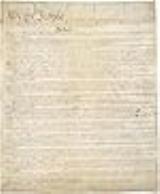
United States Constitution
The Constitution of the United States is the supreme law of the United States of America. It is the framework for the organization of the United States government and for the relationship of the federal government with the states, citizens, and all people within the United States.The first three Articles of the Constitution establish the three branches of the national government: a...
Timeline of Events
|
1787
|
|
|||||||
|
1788
|
|
|||||||
|
1789
|
|
|||||||
|
1790
|
|
|||||||
|
1795
|
|
|||||||
|
1803
|
|
|||||||
|
1909
|
|
|||||||
|
1920
|
|
|||||||
|
1964
|
|
|||||||
|
1992
|
|
|||||||
|
1998
|
|

